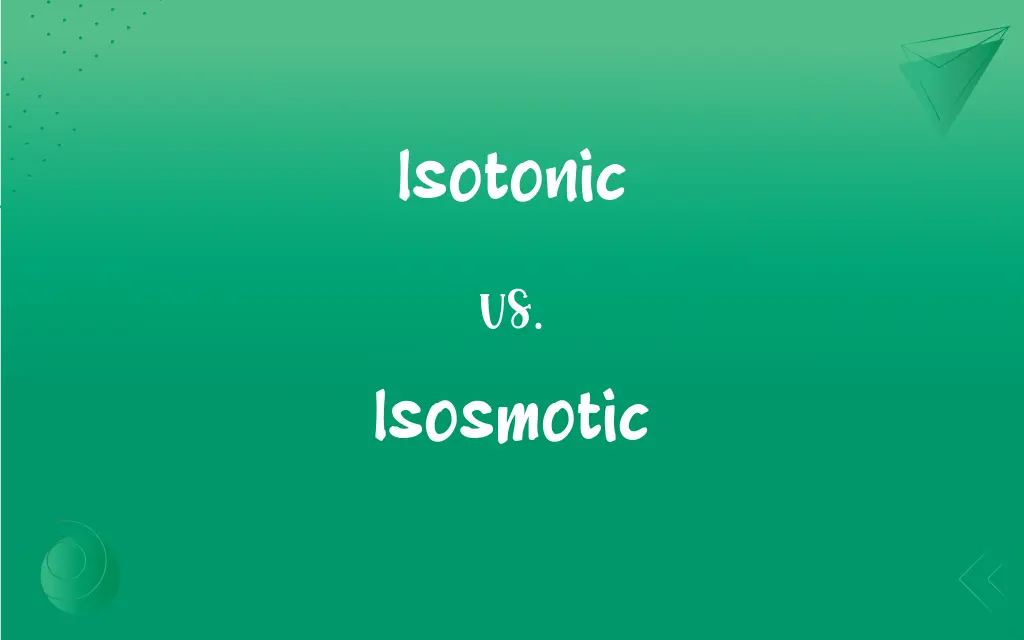Isotonic vs. Isosmotic: What's the Difference?
Edited by Aimie Carlson || By Harlon Moss || Published on January 26, 2024
Isotonic refers to solutions with equal solute concentration and osmotic pressure as another solution, while isosmotic refers to solutions having the same osmotic pressure irrespective of solute composition.

Key Differences
Isotonic solutions have the same solute concentration and osmotic pressure as another solution, typically related to biological fluids. Isosmotic solutions, however, focus solely on having the same osmotic pressure, not necessarily the same solute concentration.
In an isotonic solution, water and solute movement across a membrane is balanced, preventing cell shrinking or swelling. Isosmotic solutions ensure equilibrium in osmotic pressure, but solute types may differ, impacting biological processes.
Isotonicity is crucial in medical solutions to match blood plasma, maintaining cell integrity. Isosmotic conditions, while maintaining osmotic balance, might not consider the impact of specific solutes on cells.
Examples of isotonic solutions include saline and some IV fluids used in healthcare. Isosmotic solutions are used in research to study osmosis without altering cell volume significantly.
Isotonic solutions are often used in sports drinks to replenish fluids and electrolytes. Isosmotic conditions are key in laboratory experiments to understand osmotic effects without solute-specific influences.
ADVERTISEMENT
Comparison Chart
Definition
Equal solute concentration and osmotic pressure
Equal osmotic pressure regardless of solutes
Primary Focus
Concentration and pressure balance
Osmotic pressure balance
Biological Impact
Maintains cell size and function
Maintains osmotic balance, varying solutes
Medical Application
IV fluids, sports drinks
Laboratory research, osmotic studies
Solute Consideration
Specific solute types matter
Focus on pressure, not solute types
ADVERTISEMENT
Isotonic and Isosmotic Definitions
Isotonic
Prevents cell swelling or shrinking.
Isotonic solutions are used to avoid cell damage during treatments.
Isosmotic
Maintains osmotic equilibrium.
Isosmotic conditions help study cellular behavior without volume change.
Isotonic
Equal solute concentration as another solution.
The isotonic saline solution is ideal for IV infusions.
Isosmotic
Equal osmotic pressure to another solution.
Isosmotic solutions are used in osmosis experiments.
Isotonic
Common in medical solutions to match blood plasma.
Isotonic IV fluids are compatible with human blood plasma.
Isosmotic
Focused on osmotic balance, not solute types.
Isosmotic solutions can have different solutes but maintain pressure balance.
Isotonic
Balanced water and solute movement across membranes.
Isotonic environments are crucial for maintaining healthy red blood cells.
Isosmotic
Used in research for osmotic effects.
Isosmotic solutions are crucial in studying osmoregulation in cells.
Isotonic
Same osmotic pressure as body fluids.
Isotonic drinks help athletes maintain hydration.
Isosmotic
Ensures osmotic pressure equilibrium in laboratory settings.
Isosmotic environments are created in labs to mimic certain physiological conditions.
Isotonic
Of equal tension.
Isosmotic
Of or exhibiting equal osmotic pressure.
Isotonic
Isosmotic.
Isosmotic
Having the same osmotic pressure
Isosmotic
Having the same or equal osmotic pressure; isotonic; - used of solutions. Contrasted with hypertonic and hypotonic
Isosmotic
(used of solutions) having the same or equal osmotic pressure
FAQs
What does isotonic mean?
Isotonic refers to solutions with equal solute concentration and osmotic pressure as another solution.
What is isosmotic?
Isosmotic describes solutions with the same osmotic pressure, regardless of solute composition.
How does an isotonic solution affect cells?
It prevents cells from swelling or shrinking by maintaining a balance of solute and water movement.
What is the main focus of isosmotic solutions?
The main focus is maintaining osmotic pressure balance.
Can isosmotic solutions vary in solute composition?
Yes, they can have different solutes but must maintain the same osmotic pressure.
Are sports drinks isotonic?
Many sports drinks are formulated to be isotonic to aid in hydration and electrolyte replenishment.
How do isotonic solutions support athletes?
They help in quick fluid and electrolyte replenishment during physical exertion.
Why are isotonic solutions important in medicine?
They are used in IV fluids and other medical applications to maintain cell integrity and function.
Why are isosmotic solutions used in labs?
They are used to study osmotic effects without altering cell volume or function due to solute differences.
Are all isosmotic solutions safe for medical use?
Not necessarily, as their solute composition might not be compatible with human cells.
What role do isotonic solutions play in cellular health?
They help maintain cellular health by preventing osmotic stress.
Are isotonic solutions always safe for intravenous use?
They are generally safe, but compatibility with specific medical conditions must be considered.
Can isosmotic solutions affect cell shape?
They typically do not affect cell shape as they maintain osmotic balance.
Can an isotonic solution be isosmotic?
Yes, an isotonic solution is often isosmotic as well.
What’s the significance of solutes in isotonic solutions?
The type and concentration of solutes are important in isotonic solutions to match body fluids.
What happens to a cell in an isotonic solution?
In an isotonic solution, a cell maintains its normal size and function.
What is the key difference in application between isotonic and isosmotic solutions?
Isotonic solutions are widely used in medical treatments, while isosmotic solutions are primarily used in research.
Are isotonic and isosmotic solutions common in everyday life?
Isotonic solutions are common in medical and sports contexts, while isosmotic solutions are more specialized for research.
Can isosmotic solutions be used in medical treatments?
They are more commonly used in research rather than direct medical treatments.
How does solute concentration in isotonic solutions compare to blood?
It is generally similar to that of human blood plasma.
About Author
Written by
Harlon MossHarlon is a seasoned quality moderator and accomplished content writer for Difference Wiki. An alumnus of the prestigious University of California, he earned his degree in Computer Science. Leveraging his academic background, Harlon brings a meticulous and informed perspective to his work, ensuring content accuracy and excellence.
Edited by
Aimie CarlsonAimie Carlson, holding a master's degree in English literature, is a fervent English language enthusiast. She lends her writing talents to Difference Wiki, a prominent website that specializes in comparisons, offering readers insightful analyses that both captivate and inform.






































































